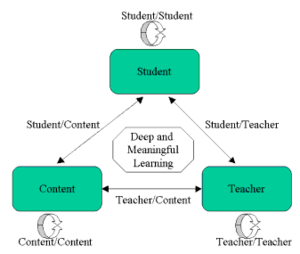Equivalency theorem: Difference between revisions
Jump to navigation
Jump to search
(Created page with "== Introduction == thumbnail|Modes of Interaction in Distance Education from Anderson and Garrison, (1998) == Links == ...") |
mNo edit summary |
||
| Line 1: | Line 1: | ||
== Introduction == | == Introduction == | ||
[[File:Modes-of-interaction-anderson-garrison-1998|thumbnail|Modes of Interaction in Distance Education from Anderson and Garrison, (1998)]] | According to the [http://equivalencytheorem.info/?page_id=2 Equivalency Theorem] website, the theorem can be summarized with two thesis, of which the first one is more important: | ||
;Thesis 1. | |||
:Deep and meaningful formal learning is supported as long as one of the three forms of interaction (student–teacher; student–student; student–content) is at a high level. The other two may be offered at minimal levels, or even eliminated, without degrading the educational experience. | |||
; Thesis 2. | |||
: High levels of more than one of these three modes will likely provide a more satisfying educational experience, although these experiences may not be as cost- or time effective as less interactive learning sequences. | |||
[[File:Modes-of-interaction-anderson-garrison-1998.png|thumbnail|Modes of Interaction in Distance Education from Anderson and Garrison, (1998)]] | |||
== Links == | == Links == | ||
| Line 10: | Line 18: | ||
* Anderson, T. (2003). Getting the mix right again: An updated and theoretical rationale for interaction. The International Review of Research in Open and Distance Learning (IRRODL), 4(2). [http://www.irrodl.org/index.php/irrodl/article/view/149/230 HTML] | * Anderson, T. (2003). Getting the mix right again: An updated and theoretical rationale for interaction. The International Review of Research in Open and Distance Learning (IRRODL), 4(2). [http://www.irrodl.org/index.php/irrodl/article/view/149/230 HTML] | ||
* Miyazoe, T., & Anderson, T. (2010). The interaction equivalency theorem. Journal of Interactive Online Learning (JIOL), 9(2), 94-104. [http://www.ncolr.org/jiol/issues/pdf/9.2.1.pdf PDF] | |||
* Miyazoe, T. (2012.02.27). Getting the Mix Right Once Again: A Peek into the Interaction Equivalency Theorem and Interaction Design. ALT News Letter. [http://newsletter.alt.ac.uk/2012/02/getting-the-mix-right-once-again-a-peek-into-the-interaction-equivalency-theorem-and-interaction-design/ HTML] | |||
[[Category: Instructional design models]] | [[Category: Instructional design models]] | ||
Revision as of 12:54, 23 December 2014
Introduction
According to the Equivalency Theorem website, the theorem can be summarized with two thesis, of which the first one is more important:
- Thesis 1.
- Deep and meaningful formal learning is supported as long as one of the three forms of interaction (student–teacher; student–student; student–content) is at a high level. The other two may be offered at minimal levels, or even eliminated, without degrading the educational experience.
- Thesis 2.
- High levels of more than one of these three modes will likely provide a more satisfying educational experience, although these experiences may not be as cost- or time effective as less interactive learning sequences.
Links
- http://equivalencytheorem.info, the home page
Bibliography
- Anderson, T. (2003). Getting the mix right again: An updated and theoretical rationale for interaction. The International Review of Research in Open and Distance Learning (IRRODL), 4(2). HTML
- Miyazoe, T., & Anderson, T. (2010). The interaction equivalency theorem. Journal of Interactive Online Learning (JIOL), 9(2), 94-104. PDF
- Miyazoe, T. (2012.02.27). Getting the Mix Right Once Again: A Peek into the Interaction Equivalency Theorem and Interaction Design. ALT News Letter. HTML
